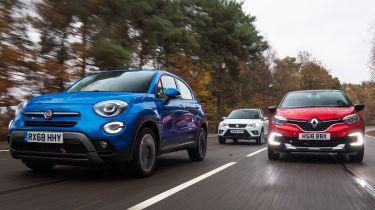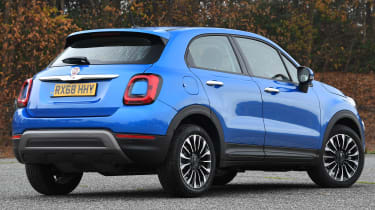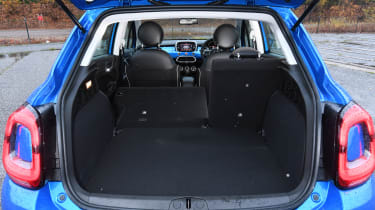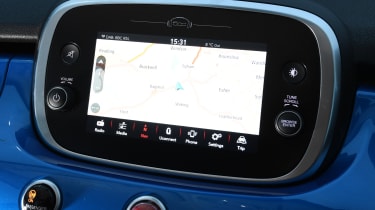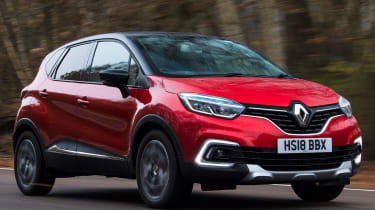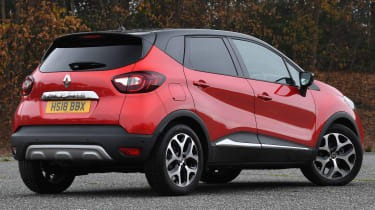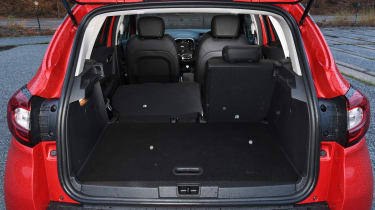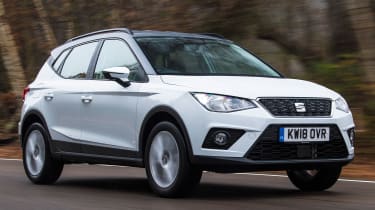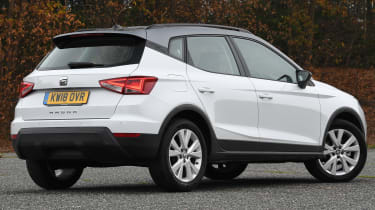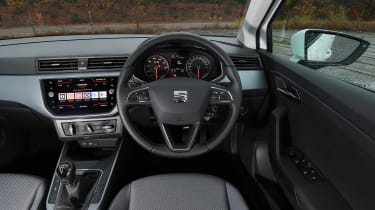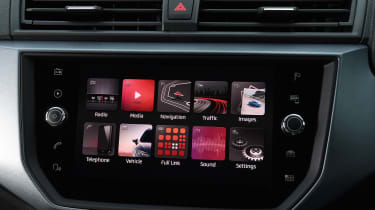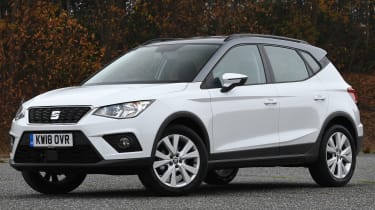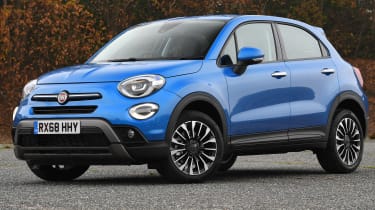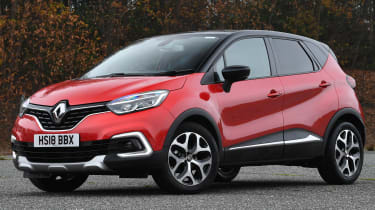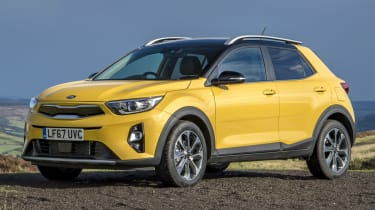Fiat 500X vs Renault Captur vs SEAT Arona
We see if new turbo engine and fresh tech have given Fiat’s 500X the edge against small SUVs from Renault and SEAT
Downsized petrol turbo engines have changed the face of the small SUV market, and Fiat’s 500X has been missing out on this technology next to its rivals. However, the Italian brand has been working feverishly to rectify the situation with this updated version of its retro-styled 500X.
There are some design tweaks that ape the firm’s 500 city car, but the big news here is the fresh 1.0-litre three-cylinder turbo petrol. This should make the 500X more competitive against rivals that have boasted similar units from the start.
Just like the little Fiat, those competitors are focused on design and, for the purposes of this test, come in the form of the updated Renault Captur and the SEAT Arona. Both SUVs promise efficiency, strong infotainment technology and features that make living with a car that little bit easier.
So that’s exactly what the 500X has got to live up to. Customisation is also an increasingly important factor in this sector, and the design of each model lends itself well to adding a personal element to the specification.
The winner will have to match its style with sufficient substance, then, because buyers in this class have exacting standards and want ability in many areas. So which should find favour if you’re in the market for a small petrol SUV
Fiat 500X
| Model: | Fiat 500X Cross Look 1.0 FireFly Turbo City Cross |
| Price: | £18,995 |
| Engine: | 1.0-litre 3cyl turbo, 118bhp |
| 0-60mph: | 9.9 seconds |
| Test economy: | 37.1mpg/8.2mpl |
| CO2: | 133g/km |
| Annual road tax: | £140 |
Fiat is hoping this mid-life update will reinvigorate sales of its 500X in this ultra-competitive class, thanks to a fresh engine line-up, some cosmetic tweaks and new kit. We’re testing the Cross Look model with the 1.0-litre petrol turbo triple in City Cross trim. Prices start from £18,995.
Design & Engineering
The 500X takes the retro design cues from Fiat’s 500 city car and upscales them for the compact SUV, so the new LED running lights and ‘hollow’ tail-lamps will be familiar. Yet it’s what’s under the skin that’s more newsworthy.
Used - available now

2020 Jaguar
F-Pace
31,770 milesAutomaticDiesel3.0L
Cash £25,890
2024 Peugeot
5008
40,906 milesAutomaticDiesel1.5L
Cash £20,197
2023 Ford
Focus
14,538 milesManualPetrol1.0L
Cash £17,087
2023 Jaguar
E-PACE
20,181 milesAutomaticDiesel2.0L
Cash £24,287That’s because the 500X is now available with a 118bhp 1.0-litre three-cylinder turbo petrol engine that gives more easily accessible performance and improved efficiency. It’s linked to a manual box that sends power to the front wheels; unlike some other small SUVs, there is no four-wheel-drive option here.
The platform on which the car is based is the same as before, with minimal changes to the set-up. The engine tech, extra connectivity and an improvement in the safety functions on offer are the real story.
There’s a 3D sat-nav system by TomTom, while CarPlay and Android Auto are now standard, so you don’t need to spend £250 on the navigation option if you’re an Apple or Android smartphone user.
More driver assistance functions also feature, including traffic sign recognition and lane assist on all models. You can upgrade this with autonomous braking, blind spot alert and adaptive cruise.
Quality still isn’t the 500X’s strongest suit, though. The design could be better ergonomically, despite claimed improvements from Fiat. Materials are okay, but are no match in particular for the SEAT, which feels worth the extra compared with its rivals here.
Driving
We’ll start with the engine, which is an improvement on that of the old 500X. With 118bhp and 190Nm of torque, it feels relatively punchy. The Fiat managed to dip just under the 10-second barrier from 0-60mph in our performance tests, taking 9.9 seconds, but it was hampered by its not-so-nice clutch action and crunchy gearchange when switching ratios quickly.
However, as long as you don’t ask too much of the car’s powertrain, it’s acceptable. The low-down torque means it pulls well after an initial snatch and then hesitation on the throttle sometimes.
Its flexibility was highlighted by strong in-gear times. The 500X was faster than the Arona from 50 to 70mph in fifth and sixth, taking 9.0 and 11.7 seconds respectively, compared with 9.4 and 13.1 seconds for the SEAT, but then the Fiat is helped by its shorter gearing. Yet its higher cruising revs don’t hurt refinement, because the 1.0 unit is quiet and smooth.
What’s not so refined is the ride. While it doesn’t crash over bumps, the chassis never feels settled and much more movement is transmitted through the suspension, jostling the body and occupants around.
This obviously affects comfort on the move, even on flatter A-roads and motorways, where the 500X’s damping doesn’t ever really smooth out, but it also has an impact on how the car handles. As a result of the bobbling ride and lack of filtration from the suspension, the 500X isn’t as stable in corners as the SEAT. While there’s enough grip, the steering doesn’t give you much of a sense of this. It feels resistant when applying lock round the straight-ahead, but too eager to spring back to the centre when you have lock on.
Practicality
Although the 350 litres of boot space should be adequate for most buyers’ needs most of the time, the Fiat’s load bay is still the smallest of the three.
Practicality is acceptable, however, and the sloping roofline at the rear doesn’t hurt interior space too badly, either. There’s not quite as much rear legroom as in the SEAT, but it feels more spacious than the Captur. Headroom is good as well.
You get a similar sensation in the front seats, and the windscreen feels quite far away, so the 500X seems roomy. The big dashboard does dominate the cabin, however, and we feel the space could have been used more effectively here, because storage is merely acceptable rather than great. Anything more than a phone and a wallet could cause a problem, but at least the door bins are sizeable, with enough space for a big bottle.
Ownership
Fiat finished 23rd out of 26 in the makers’ chart of our Driver Power 2018 satisfaction survey, but this still wasn’t the worst of the three manufacturers here, because Renault came one position lower.
With a three-year, 60,000-mile warranty, the Italian SUV matches its rivals, although it trails their safety scores. When the 500X was originally crash tested in 2015 by Euro NCAP, it only achieved a four-star rating. Autonomous braking isn’t standard and comes as part of a £650 pack that also adds blind spot monitoring. However, lane-keep assist is included.
Running costs
A downsized turbocharged petrol engine has to deliver economy, because this will be a big factor in buyers’ decisions, and while the Fiat’s result of 37.1mpg on test was good, it still wasn’t as frugal as its rivals’.
The Captur achieved a little more, at 38.2mpg, while the Arona managed the best result during the test, at 41.4mpg. Both these cars are significantly lighter, which will have counted against the 500X here. As a result, the Fiat will cost you £1,850 in fuel over a year’s driving (based on an annual mileage of 12,000 miles), compared with £1,797 and £1,658 for the Renault and SEAT respectively.
Renault Captur
| Model: | Renault Captur TCe 90 GT Line |
| Price: | £18,725 |
| Engine: | 900cc 3cyl turbo, 89bhp |
| 0-60mph: | 13.5 seconds |
| Test economy: | 38.2mpg/8.4mpl |
| CO2: | 122g/km |
| Annual road tax: | £140 |
The Captur is a compact and stylish SUV that, with this downsized petrol engine we’re testing, is a car the 500X will have to beat. Prices start from £18,725 for this top-spec TCe 90 GT Line model, so it’s more affordable than the Fiat.
Design & engineering
Like the 500X, the Renault Captur places plenty of its focus on style, and that’s where the majority of its 2018 updates feature, both inside and outside.
The changes are subtle, but the tweaked styling gives this version of the Captur a more rugged and sporty look. There’s a new trim structure, too, with the range-topping GT Line we’re testing replacing the previous Signature X Nav model.
Much of the Captur’s engineering is shared with the firm’s Clio supermini, including its Renault B platform, only it’s been raised up here to give the car an off-road look.
The TCe 90 engine is also shared with the Clio. Renault has recently discontinued the 1.2-litre TCe 120, so this less powerful 89bhp 0.9-litre three-cylinder turbo petrol is the only choice. While it’s down on power to the tune of 29bhp compared with the Fiat, you get more kit. And in day-to-day use, this could matter more to potential buyers.
Top-spec GT Line trim brings parking sensors to match the Fiat and SEAT, but also a reversing camera is fitted as standard. It’s an option on the 500X and not available on the FR-spec Arona.
In addition, the Renault features an acceptable level of kit, heated leather seats, LED lights and keyless entry. All three cars have climate and cruise control.
Driving
That power deficit to its rivals is noticeable once you’re underway, because the Captur feels gutless – not just in comparison with its more pokey competitors here, but just generally lacking grunt.
Our performance data proves this, because the Renault took 13.5 seconds to accelerate from 0-60mph at the track. This was 3.6 seconds slower than the Fiat and 4.5 seconds behind the SEAT.
It also took a yawning 21.2 seconds to go between 50 and 70mph in top gear, which in this Captur is only fifth. While its rivals both use six-speed manual transmissions, the Renault makes do with five ratios to cover a similar speed range, which partly explains its performance deficit.
The other reason is the TCe unit’s lower 140Nm torque output. This also comes in higher in the rev range than in its rivals, at 2,250rpm, which means you have to work the motor harder.
It’s not the only frustrating element of the package, because the ride breaks down all too easily with the surface. Pock-marked roads make up plenty of the UK network in towns and the countryside, so the Captur’s inconsistencies mean you won’t know whether to expect a wallowing soft response or a crashing thud.
The Renault feels soft and rolls even at medium speeds through corners, but there’s very little compliance in the dampers to soak up inputs in bends; it doesn’t feel anywhere near as stable or as composed as the SEAT, while the Fiat seems more dynamically capable despite the fact the Renault is better resolved on the motorway, because its chassis is upset less. Refinement is at least okay, even if you have to rev that engine relatively hard due to its power deficit. You have to work the transmission, too, and it’s not the sweetest shift action, either. The Arona’s gearbox is much better.
Practicality
The Captur’s footprint is smaller than the 500X’s, but there’s more boot space on offer, at 377 litres – beating the Fiat by 27 litres. However, room in the back isn’t so great. The tall roofline gives plenty of headroom, but taller passengers will struggle for legroom in the rear.
The cabin layout is about as practical as the Fiat’s. There’s acceptable storage in the front, with average-sized door bins and some elasticated straps fitted on to the rear of the front seats, which are a neat solution for holding bits and bobs.
Ownership
Renault recorded a worse finish than Fiat in Driver Power 2018, coming 24th in the makers’ standings. It’s not a great result for the company, which was marked down in the twenties in every category but one.
Its dealers were rated similarly poorly, ranking 27th and bottom of the table. For reference, Fiat’s garages finished in 15th, while SEAT’s official network came 23rd according to your experiences with the different manufacturers.
At least things look up when it comes to safety, because the Renault went one better than the Fiat in its Euro NCAP crash tests and scored a full five-star crash test rating. However, this was in 2013, two years before the original 500X was rated.
The car comes with six airbags and blind spot warning, but autonomous braking isn’t available. At least there are parking sensors and a reversing camera to make it easier when manoeuvring.
Running costs
The Renault splits its rivals here with its 122g/km CO2 emissions. The Fiat produces 133g/km and the SEAT 114g/km.This puts the three cars in the 25, 27 and 23 per cent Benefit-in-Kind tax brackets respectively, but because the Captur is the cheapest choice, business users will pay just £925 in company car tax for this model if they’re a lower-rate earner.
This compares with £8 less for the more efficient Arona, while the 500X will set you back £1,012 in company car tax contributions.
SEAT Arona
| Model: | SEAT Arona 1.0 TSI 115 FR |
| Price: | £20,165 |
| Engine: | 1.0-litre 3cyl turbo, 113bhp |
| 0-60mph: | 9.0 seconds |
| Test economy: | 41.4mpg/9.1mpl |
| CO2: | 114g/km |
| Annual road tax: | £140 |
The SEAT Arona is one of the sportier small SUVs on sale, but it matches up to the 500X for its focus on style, as well as for performance with the 1.0 TSI 115 model we’re testing here. However, in FR trim it starts from £20,165, so is £1,170 more expensive than the Fiat. Is it worth the extra?
Design & engineering
The Arona arrived last year and over the past 12 months has cemented itself as one of our favourite small SUVs for a number of reasons. SEAT’s MQB chassis is still one of the best in the business. It’s a modular platform that uses the same MacPherson-strut front suspension and torsion-beam rear layout as its rivals, but it’s clear the SEAT is better set up, as we’ll see.
The engine is also part of why the package is so good. It’s a 1.0-litre three-cylinder turbocharged petrol unit with 113bhp and 200Nm of torque. This last figure is important, because it’s the most here, beating the Fiat by 10Nm and the Renault by 60Nm. It’s paired with a six-speed manual box that sends power to the front; there’s no four-wheel drive.
And there’s another area where the SEAT rivals the Fiat and Renault. Striking styling and sharp lines are complemented by bold paint colours – metallic is standard, but a £550 option on both of its rivals – and contrasting roofs. The silver blade that runs from the C-pillar under the windows and the ‘X’ graphic boost its visual impact.
It’s backed up by the engineering underneath, but there’s also quality to justify the higher price tag. The SEAT’s materials are plusher compared with its rivals’ cabins. There’s a good level of kit, too. Parking sensors, sat-nav, CarPlay and Android Auto are all standard, as are DAB, connected services, LED lights, climate and cruise control and autonomous braking.
However, due to the way SEAT has structured the Arona range, there are very few options, so you won’t be able to add features such as a reversing camera, or any extra safety technology. In fact, a space-saver spare wheel (£105) and a body-coloured roof (no cost) are the only real choices.
Driving
Only a few miles behind the wheel are enough to confirm that the Arona is, by some margin, the best car to drive here. And its advantage comes from every area.
The engine is punchier and smoother. It took 9.0 seconds to accelerate from 0-60mph, 0.9 seconds faster than the more powerful but heavier Fiat and 4.5 seconds quicker than the Captur. Thanks to the Arona’s taller ratios, it wasn’t quite as fast as the Fiat in gear, but the SEAT almost matched the 500X, although it’s more refined on the motorway.
That’s helped by the ride. Despite the Spanish model’s sportier focus, the dampers are more compliant, with a plusher feel. The body is less prone to movement over bumps and the forces thrown back at the suspension by a pothole are better controlled here, for example. It feels less busy and smoother than both the cars it’s up against.
However, the Arona’s greatest trick is that it’s also more agile and responsive. The steering is more accurate, the car rolls less and there’s more grip. Not many small SUVs are that rewarding to drive, but the Arona makes a genuine stab at driver enjoyment, yet it doesn’t compromise much in other areas.
The gearshift is a great example of this: it feels more mechanical than the action in the SEAT’s rivals, so you enjoy the process. But the gearlever is also light and easy to use around town.
Practicality
Despite its more compact footprint compared with the Fiat, the SEAT has a bigger boot, at 400 litres. However, this extra load space over the 500X doesn’t compromise room in the rear, because there’s a good level of legroom. The high roofline means even taller passengers won’t brush their heads inside.
The front of the cabin doesn’t feel as compromised as either the Fiat or the Renault as well. It’s more spacious, the driving position is more natural and forward visibility is also better. Rear visibility is about the same as its rivals’.
There’s more smart use of space inside, too. For example, the slot in front of the gearlever for your mobile phone makes use of what would otherwise be redundant space. The rest of the cabin storage is roughly on par with the 500X and Captur, including the big bin between the front seats.
Ownership
The Arona’s five-star Euro NCAP crash test result means it’s the only car of this trio to score a full rating under the newer testing regime; the Captur was assessed in 2013 when the standards weren’t quite as rigorous.
You get six airbags and autonomous braking as standard, which is a solid level of kit because its rivals don’t feature the latter. But you can’t add extra protection such as blind spot or lane-keep assist.
Running costs
Many people in this class buy on PCP finance, and you can see the relative deals on offer for each model in our Through the Range panels. If you’re a cash buyer then depreciation will be a big factor when it comes to running costs, and the Arona is stronger here. Our experts predict the SEAT will retain 45.1 per cent of its list price – or £9,100 – over three years or 36,000 miles. The Fiat and Renault are relatively evenly matched, holding on to 38.2 and 38.0 per cent respectively, which means residual values of £7,250 and £7,123 after the same ownership period.
Even though the Arona is pricier to buy initially, it’ll lose less so will be worth more than its rivals.
Results
First place: SEAT Arona
The Arona is head and shoulders above the crowd here. It’s faster, sweeter to drive, more efficient, more practical and rides better than its rivals. The infotainment is the strongest of this trio and the SEAT is even affordable on finance – which is how most people buy – despite costing more to purchase outright. The Arona is easily worth that premium, though, and is the strongest all-rounder here.
Second place: Fiat 500X
Mechanical tweaks have improved the 500X, and it’s as stylish as ever. The engine is genuinely competitive, punchy and smooth, but the gearshift can’t match it. The Fiat’s ride is never settled, which is frustrating, and although the latest version is practical enough and the technology better, the new motor’s poor efficiency is a downside.
Third place: Renault Captur
The restructured Captur range means only the TCe 90 engine is available, so the Renault crossover is slower than its rivals. However, it’s also cheaper to buy and emits less CO2, so should be cost-effective to run. Quality is a little questionable in places, while the Captur isn’t as practical as the Fiat and the infotainment system is only average, so it loses out here.
Other options in this category...
Kia Stonic
Model: Kia Stonic 1.0 T-GDi ‘3’Price: £18,600Engine: 1.0-litre 3cyl, 118bhp
The Stonic is a stylish and relatively new entrant to this class, but in ‘3’ trim it blends decent practicality, a refined engine and lots of attractive kit, especially the infotainment. We’d recommend this small Korean SUV over the 500X.
Mazda CX-3
Model: Mazda CX-3 SkyActiv-G 2.0 SE Nav+Price: £18,995Engine: 2.0-litre 4cyl, 119bhp
Mazda has updated the CX-3 this year, and it’s still a fine compact crossover. It’s as sporty as the SEAT Arona, but not quite as practical. However, even in SE Nav trim there’s loads of kit and a nice cabin, while it’s more affordable, too.
| SEAT Arona 1.0 TSI 115 FR | Fiat 500X Cross Look 1.0 FireFly Turbo City Cross | Renault Captur TCe 90 GT Line | |
| On the road price/total as tested | £20,165/£20,165 | £18,995/£22,100 | £18,725/£18,300 |
| Residual value (after 3yrs/36,000) | £9,100/45.1% | £7,250/38.2% | £7,123/38.0% |
| Depreciation | £11,065 | £11,745 | £11,602 |
| Annual tax liability std/higher rate | £917/£1,835 | £1,012/£2,023 | £925/£1,851 |
| Annual fuel cost (12k/20k miles) | £1,658/£2,763 | £1,850/£3,083 | £1,797/£2,994 |
| Insurance group/quote/VED | 12/£411/£140 | 10/£417/£140 | 9/£357/£140 |
| Cost of servicing | £18 per month (2yrs) | £69 per service | £299 (3yrs) |
| Length/wheelbase | 4,138/2,566mm | 4,269/2,570mm | 4,122/2,606mm |
| Height/width | 1,543/1,780mm | 1,595/1,796mm | 1,566/1,778mm |
| Engine | 3cyl in-line/999cc | 3cyl in-line/999cc | 3cyl in-line/898cc |
| Peak power/revs | 113/5,000 bhp/rpm | 118/5,750 bhp/rpm | 89/5,500 bhp/rpm |
| Peak torque/revs | 200/2,000 Nm/rpm | 190/1,750 Nm/rpm | 140/2,250 Nm/rpm |
| Transmission | 6-speed man/fwd | 6-speed man/fwd | 5-speed man/fwd |
| Fuel tank capacity/spare wheel | 40 litres/£105 | 48 litres/£100 | 45 litres/repair kit |
| Boot capacity (seats up/down) | 400 litres/N/A | 350/1,000 litres | 377/1,235 litres |
| Kerbweight/payload/towing weight | 1,189/521/1,200kg | 1,320/N/A/1,000kg | 1,173/486/900kg |
| Turning circle | 10.6 metres | 11.5 metres | 11.3 metres |
| Basic warranty (miles)/recovery | 3yrs (60,000)/2yrs | 3yrs (60,000)/1yr | 3yrs (60,000)/3yrs |
| Driver Power manufacturer/dealer pos. | 14th/23rd | 23rd/15th | 24th/27th |
| NCAP: Adult/child/ped./assist/stars | 95/80/77/60/5 (2017) | 86/85/74/64/4 (2015) | 88/79/61/81/5 (2013) |
| 0-60/30-70mph | 9.0/9.2 secs | 9.9/9.3 secs | 13.5/13.1 secs |
| 30-50mph in 3rd/4th | 4.3/6.4 secs | 4.3/6.0 secs | 5.5/10.3 secs |
| 50-70mph in 5th/6th/7th/8th | 9.4/13.1 secs | 9.0/11.7 secs | 21.2 secs/N/A |
| Top speed/rpm at 70mph | 113mph/2,300rpm | 117mph/2,800rpm | 106mph/3,000rpm |
| Braking 70-0/60-0/30-0mph | 51.6/35.1/8.2m | 43.8/32.0/8.5m | 50.6/37.8/9.6m |
| Noise outside/idle/30/70mph | 68/52/65/73dB | 70/44/62/70dB | 47/70/67/72dB |
| Auto Express econ. (mpg/mpl)/range | 41.4/9.1/364 miles | 37.1/8.2/392 miles | 38.2/8.4/378 miles |
| Govt urban/extra-urban/combined | 48.7/61.4/56.5mpg | 40.4/55.4/48.7mpg | 44.8/58.8/52.3mpg |
| Govt urban/extra-urban/combined | 10.7/13.5/12.4mpl | 8.9/12.2/10.7mpl | 9.9/12.9/11.5mpl |
| Actual/claimed CO2/tax bracket | 158/114g/km/23% | 176/133g/km/27% | 171/122g/km/25% |
| Airbags/Isofix/park sensors/camera | Six/yes/yes/no | Six/yes/yes/£200* | Six/yes/yes/yes |
| Auto box/lane keep/blind spot/AEB | £1,180/no/no/yes | No/no/£650*/£650* | No/no/yes/no |
| Clim ctrl/cruise/leather/heated seats | Yes/yes/no/no | Yes/yes/£850/£400* | Yes/yes/yes/yes |
| Metallic/LEDs/keyless/power tailgate | Yes/yes/no/no | £550/£750*/£450*/n | £550/yes/yes/no |
| Nav/digi dash/DAB/connected services | Yes/no/yes/yes | £250/no/yes/yes | Yes/no/yes/yes |
| Wireless charge/CarPlay/Android Auto | Yes/yes/yes | No/yes/yes | £130/no/yes |
